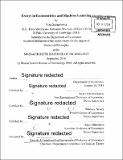| dc.contributor.advisor | Victor Chernozhukov, Whitney Newey and Anna Mikusheva. | en_US |
| dc.contributor.author | Semenova, Vira. | en_US |
| dc.contributor.other | Massachusetts Institute of Technology. Department of Economics. | en_US |
| dc.date.accessioned | 2019-10-11T22:11:07Z | |
| dc.date.available | 2019-10-11T22:11:07Z | |
| dc.date.copyright | 2018 | en_US |
| dc.date.issued | 2018 | en_US |
| dc.identifier.uri | https://hdl.handle.net/1721.1/122542 | |
| dc.description | Thesis: Ph. D., Massachusetts Institute of Technology, Department of Economics, 2018 | en_US |
| dc.description | Cataloged from PDF version of thesis. | en_US |
| dc.description | Includes bibliographical references (pages 209-213). | en_US |
| dc.description.abstract | Establishing the link between a cause and effect is a fundamental question in social science. Standard assumptions about human behavior (e.g., rationality) imply restrictions on the plausible values of the causal effect. In addition to this effect, these restrictions may depend on additional summaries of human behavior. Estimation of these additional parameters presents a trade-off between capturing the complexity of human's decision-making yet constraining it to deliver precise estimates. I resolve this tension by incorporating modern machine learning tools into the estimation of the additional parameters and deliver high-quality estimates of the causal effect and counterfactual outcomes. I estimate the causal effect in a two-stage procedure. At the first stage, I estimate the additional summaries of human behavior by modern machine learning tools. At the second stage, I plug the first-stage output into the sample analog of the restriction that identifies the causal effect. I modify the second-stage restriction to make it insensitive to any regularization biases present in the first-stage components. The second-stage estimate of the causal effect is of high-quality: it converges at fastest rate and can be used to test the hypotheses and build the confidence intervals for the values of the causal effect. I apply this idea in a wide class of economic models, including dynamic games of imperfect information, treatment effect in the presence of endogenous sample selection, and reduced-form demand estimation. | en_US |
| dc.description.statementofresponsibility | by Vira Semenova. | en_US |
| dc.format.extent | 213 pages | en_US |
| dc.language.iso | eng | en_US |
| dc.publisher | Massachusetts Institute of Technology | en_US |
| dc.rights | MIT theses are protected by copyright. They may be viewed, downloaded, or printed from this source but further reproduction or distribution in any format is prohibited without written permission. | en_US |
| dc.rights.uri | http://dspace.mit.edu/handle/1721.1/7582 | en_US |
| dc.subject | Economics. | en_US |
| dc.title | Essays in econometrics and machine learning | en_US |
| dc.type | Thesis | en_US |
| dc.description.degree | Ph. D. | en_US |
| dc.contributor.department | Massachusetts Institute of Technology. Department of Economics | en_US |
| dc.identifier.oclc | 1121629417 | en_US |
| dc.description.collection | Ph.D. Massachusetts Institute of Technology, Department of Economics | en_US |
| dspace.imported | 2019-10-11T22:11:06Z | en_US |
| mit.thesis.degree | Doctoral | en_US |
| mit.thesis.department | Econ | en_US |
